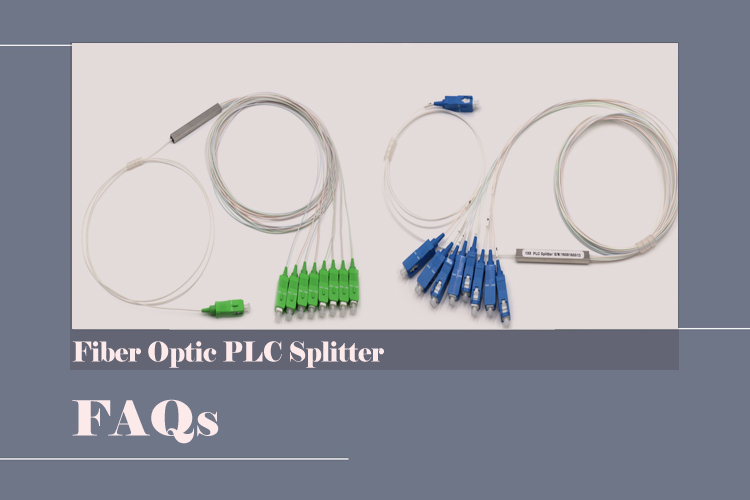By goodvin | 28 July 2023 | 0 Comments
Fiber Optic PLC Splitter FAQs
Fiber Optic PLC Splitter FAQs
In today's fast-paced digital age, where connectivity is a necessity, businesses and individuals alike rely heavily on reliable and high-speed internet connections. Behind the scenes, fiber optic technology plays a crucial role in ensuring the efficient transmission of data over long distances. Among the many components that contribute to this seamless data transfer, the fiber optic PLC splitter stands out as a key element in enhancing network efficiency and scalability.

1. What is a fiber optic PLC splitter?
A fiber optic PLC (Planar Lightwave Circuit) splitter is a passive optical device that divides an input optical signal into multiple output signals with minimal signal loss. PLC splitters are fabricated using silica glass substrates and unique manufacturing processes that allow for high levels of precision, compactness, and consistency. They are commonly used in fiber-to-the-home (FTTH) networks, passive optical networks (PONs), local area networks (LANs), and various other telecom and datacom applications.
2. How does a fiber optic PLC splitter work?
A PLC splitter works by using waveguide technology to split and distribute optical signals. The input fiber carries the light signal to an input waveguide that is then guided onto a planar substrate. The waveguide on the substrate is designed to split the light following specific splitting ratios (e.g., 1:2, 1:4, 1:8). The light exiting the waveguides is then coupled to their corresponding output fibers.
This process ensures minimal signal loss, offers uniform power distribution amongst output fibers, and maintains the original input signal’s polarization and wavelength. PLC splitters exhibit low insertion loss, low polarization-dependent loss (PDL), and minimal signal distortion compared to other types of splitters like Fused Biconical Taper (FBT) splitters.
3. What are the different types of fiber optic PLC splitters?
Fiber optic PLC splitters can be classified based on different factors, such as the connectivity, packaging, and splitting ratios:
a) Connectivity: PLC splitters can be found as bare fiber splitters (no connectors attached) and connectorized splitters (with connectors like SC, LC, or FC).
b) Packaging: PLC splitters can come in different packaging options, such as bare chips (without housing), blockless (compact housing), and modular types (like LGX, 19" rack mount, and other custom configurations).
c) Splitting ratios: PLC splitters are available with various splitting ratios, such as 1:2, 1:4, 1:8, 1:16, 1:32, and so on. Based on the application requirements, the user can choose the appropriate ratio for an optimal network.
4. What are some common applications of fiber optic PLC splitters?
Fiber optic PLC splitters are widely used in various optical communication systems due to their versatile and reliable performance. Some common applications include:
a) Passive Optical Networks (PONs): PLC splitters are widely used in PON systems like EPON, GPON, and BPON for distributing optical signals among multiple subscribers.
b) Fiber to the Home (FTTH): PLC splitters are crucial in FTTH deployments, enabling service providers to distribute optical signals from a central office to multiple residences.
c) Local Area Networks (LANs): In LAN systems, PLC splitters are employed for signal distribution and management within a closed network.
d) Telecommunication networks: PLC splitters play a significant role in managing signal distribution and monitoring in telecommunication networks.
e) Optical test instrumentation: PLC splitters can be used in test configurations to distribute signals for various test and measurement applications.
5. What are some key specifications to consider when selecting a fiber optic PLC splitter?
When selecting a fiber optic PLC splitter, it is essential to consider the following specifications:
a) Splitting ratio: Choose the appropriate splitting ratio (e.g., 1:2, 1:4, 1:8, 1:16, etc.) based on the number of output fibers required for the specific application.
b) Insertion loss: The insertion loss refers to the power loss that occurs when the optical signal is split. Lower insertion loss is generally preferred for better signal quality and less attenuation.
c) Polarization Dependent Loss (PDL): This refers to the signal loss that occurs due to variations in the polarization state of the input light. A low PDL value indicates better performance and consistency of the splitter.
d) Uniformity: It denotes the power distribution consistency between the output fibers. Good uniformity ensures that each output fiber receives a similar signal strength, resulting in a balanced network performance.
e) Operating wavelength range: The splitter should support the wavelength range used in the communication system, typically 1260nm to 1650nm.
f) Connector type: Choose the appropriate fiber connectors (such as LC, SC, or FC) that are compatible with your existing fiber infrastructure.
g) Packaging and form factor: Select a suitable package or form factor (bare chip, blockless, or modular) based on the design, size, and installation requirements of the optical network.
Fiber optic PLC splitters play a vital role in enhancing network efficiency and scalability. Their ability to split optical signals into multiple paths, coupled with their scalability and compact design, makes them an essential component in various fiber optic network deployments. By enabling multiple users to share a single fiber optic cable without compromising on speed or quality, PLC splitters offer a cost-effective solution for expanding network capacity. With their excellent performance characteristics, including signal stability, low insertion loss, and signal uniformity, fiber optic PLC splitters are undoubtedly a key enabler of the high-speed and reliable connectivity we depend on in today's digital world.
Leave a Reply
Your email address will not be published.Required fields are marked. *
POPULAR BLOG
- Guide to the Construction of Optical Fiber Cable Factories
- The Future of Fiber Optic Access Networks: An Expert Perspective
- Market Analysis of Fiber Optic Testing Equipment: Key Trends and Insights
- Will SDM Technology Become the Only Way for High-Capacity Optical Transmission?
- Fiber Optic Network Development Strategy and Technical Roadmap